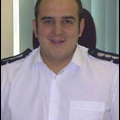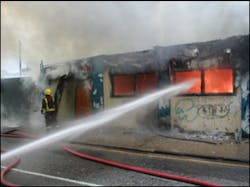As well as unprovoked attacks on crews called out to deal with routine emergencies, ambushes are being set in many areas to lure firefighters in just for an attack. A regular occurrence for crews is to be called to a fire in a derelict property in a dead end road. Once the crews are engaged in the incident, a car is driven across the end of the street and then ignited. Trapped; the firefighters then face a hail of stones, bricks and bottles.
There are many areas where police are called into certain areas on the Initial call to the fire service, sadly this is a challenge faced by crews in my area.
Tower Hamlets is the borough immediately to the East of the City of London. It has long been a poor immigrant area, with Jewish, Irish, West Indian and latterly settlers from the Indian Sub Continent (Bangladesh & Pakistan) have made the ?East End? their home.
Pre War the narrow streets of terraced houses side by side with clothing factories saw trade from across the world brought into the docks along the river thames. Most of this area was flattened during the blitz and the post-war recovery saw most of the remaining streets bull-dozed to make way for bland local authority high rise housing estates, termed ?Concrete Jungles? Many of the Riverside warehouses left derelict after the war became fuel for the arsonists from the 60?s to the 80?s.
By the Late 80?s, the area was becoming a political embarrassment, and the area was designated an ?enterprise zone? Property developers and businesses were drawn to the East End with the promise of low rent and rates. Then a property explosion occurred, The burnt out riverside warehouses were turned into Multi Million pound loft apartments and a whole new city was built on Canary Wharf, one of the old Docks that has become ?London?s Mini Manhattan? the second financial district of the capital.
Behind the new developments though all was not good. Families of immigrants, some as large as 15 people were crammed into apartments built for a family of four. Poverty is rife in this area and many of the youngsters who have clashed with their traditional Muslim beliefs and the ways of the West have felt they fitted in nowhere. As a result they formed gangs and turned to crime.
Crime in this area is among the most vicious and frightening in Europe. Gang leaders get rich by using teenagers to run drug and turf battles across the streets of the East End. Arson is one of the tools of the trade of these gangs with vehicles and properties being burnt day and night. Naturally the fire crews are called to deal with these incidents of arson and have long been seen as ?legitimate targets? for the gang members.
Since the increase in Islamic fundamentalism across the world, areas of high Islamic population including the East End have been recruiting hotbeds for those who seemingly want to bring down the Western World. Although crime is still the main occupation of the gang members the events of 9/11 have brought the fire service into the front line of the war on Terror.
In the weeks following the events of 9/11 firefighters became the target of Muslim youths with crews being attacked by gangs calling themselves names such as the ?Osama Bin Laden Crew? although this initial hysteria passed things for the firefighters of the East End have not improved.
Every year between September and December, many religious festivals are celebrated within this community these often involve fireworks and bonfires. In the middle of this, on November 5th is ?Guy Fawkes night? an historic British celebration of the man who tried to blow up the houses of Parliament in 1605.
In the run up to this time, crews in the East end often respond to 30 or 40 fires per day, the traditional celebration of Bonfires and Fireworks in Gardens has now evolved into a free for all with cars, buildings and dumpsters being ignited and industrial size fireworks being used as missiles towards people and buildings.
In 2001 the problem became so bad that a joint operation between Police and Firefighters was undertaken to reduce the problem.
Police Officers who are permanently tasked to deal with the activities of the gangs are teamed up with fire chiefs to investigate and compare intelligence regarding the gang?s activities. An operational plan was developed identifying key areas of trouble, profiles of gang behaviour and an understanding of joint operational priorities for both the police and fire service.
Action plan
- Multi Agency intelligence sharing between Police, Fire, Education and Welfare Services
- Sharing of Operational Strategies and Tactics between Police and Fire to ensure understanding and avoid conflict
- Identification of Key Trouble areas by analysis of Fire Call and Crime data
- Identification of Gang members and their ?Modus operandi? to try to predict likely behavioural patterns
- Dedicated Police ?Firework Patrols? in high Crime & Fire areas, preventing disorder and protecting Fire Crews dealing with Incidents
- Fire Officers attending Police Control rooms to provide real time advice for Police at Incidents
- Preventative work in Local Schools and Youth Clubs
- Operations with local Trading Standards Officials to limit the sale of Illegal Fireworks
- Agreed protocols for dealing with disorder i.e. Firefighters withdraw to safety until Police contain aggressors.
In the two years since the plan was established, attacks on fire crews have reduced although as in any ghetto area they will never be completely eradicated. On November 5th 2001 the six fire stations within the Borough of Tower Hamlets received over 200 calls. There were 36 reported attacks on fire crews and a number of injuries, one firefighter was hit by a firework and subsequently had to retire.
Conversely this year although by anyone?s standards the stations were still very busy at 169 calls to fire for the six stations in the Borough; Only two fire crews were attacked and no injuries were suffered as the crews evacuated the area until police arrived, police managed to arrive with crews to deal with all other incidents.
Verbal attacks were still high and a number of missiles were thrown at fire trucks travelling within the area, but all serious disorder was contained. During the evening there were three multi alarm incidents within the area that required the attendance of fire crews from outside the borough, information sharing across the London Fire Brigade before the events and information passed by radio from London Fire Brigade Control ensured all crews remained aware of problems throughout the night.
Although the problems faced in this tough area of London may be very specific to the area, fire crews around the world can face attack at anytime in a civil disorder scenario. As fire service commanders it is our duty to be proactive in ensuring the health, safety and welfare of our personnel. If there are troubles in your area are you doing all you can to protect the fire crews that serve that community?
About the Author

